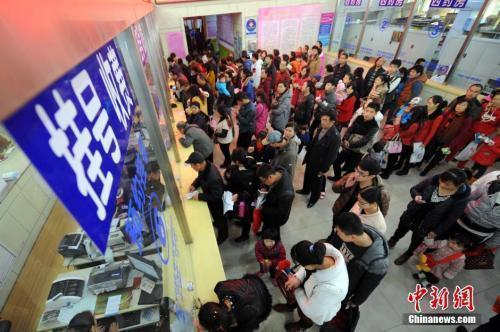In 2018, the population born in China was 15.23 million, with two children accounting for about 50%.
BEIJING, May 23 (Xinhua) According to the Statistical Bulletin on the Development of China’s Health Care in 2018 released by the National Health and Wellness Commission, there were 15.23 million people born in China in 2018, and the proportion of two children remained at around 50%.

The total number of medical and health institutions in China is nearly one million.
In terms of the number of medical and health institutions, the Bulletin shows that at the end of 2018, the total number of medical and health institutions nationwide reached 997,434, an increase of 10,785 over the previous year. Among them, there are 33,009 hospitals, 943,639 primary medical and health institutions and 18,034 professional public health institutions.
Among them, private hospitals accounted for 63.5% of the total number of hospitals in 2018, an increase of 3.1 percentage points over the previous year. The proportion of outpatients and inpatients in private hospitals increased from 14.2% and 17.6% in 2017 to 14.8% and 18.3% respectively.
In terms of the number of health workers, at the end of 2018, the total number of health workers nationwide reached 12.3 million, an increase of 551,000 (an increase of 4.7%) over the previous year. Among them, there are 9.529 million health technicians, 907,000 rural doctors and health workers, 477,000 other technicians, 529,000 managers and 858,000 workers and technicians. Among the health technicians, there are 3.607 million licensed (assistant) doctors and 4.099 million registered nurses.
In 2018, there were 2.59 licensed (assistant) doctors and 2.94 registered nurses per 1,000 population; There are 2.22 general practitioners per 10,000 population and 6.34 professional public health institutions per 10,000 population.

The average resident visits 6.0 times, and the per capita hospitalization expense exceeds 9,000 yuan.
According to the Bulletin, in 2018, the total number of outpatients nationwide increased by 130 million person-times or 1.6% over the previous year. The average number of visits by residents increased from 5.9 in 2017 to 6.0.
In 2018, the number of people admitted to medical and health institutions nationwide was 254.53 million, an increase of 10.17 million over the previous year, and the annual hospitalization rate was 18.2%, an increase of 4.2% over the previous year. The number of beds in medical and health institutions per thousand population increased from 5.72 in 2017 to 6.03.
In terms of medical expenses, in 2018, the average outpatient expenses of the hospital was 274.1 yuan, which was 6.7% higher than that of the previous year and 4.5% higher than the comparable price. The per capita hospitalization expense is 9291.9 yuan, which is 4.5% higher than that of the previous year and 2.4% higher than that of the comparable price. The average daily hospitalization expense is 1002.8 yuan.
In addition, in 2018, the average outpatient drug cost (112.0 yuan) accounted for 40.9%, down 1.8 percentage points from the previous year (42.7%); The per capita hospitalization expenses (2621.6 yuan) accounted for 28.2%, which was 2.9 percentage points lower than the previous year (31.1%).

The population born in 2018 was 15.23 million. The average life expectancy is 77 years.
According to the Bulletin, the average life expectancy of China residents has increased from 76.7 years in 2017 to 77 years in 2018, the maternal mortality rate has dropped from 19.6/100,000 to 18.3/100,000, and the infant mortality rate has dropped from 6.8‰ Down to 6.1‰ .
In terms of newborn population, there were 15.23 million people born in China in 2018, and the proportion of two children remained at about 50%. The sex ratio continues to decline steadily. Maternal and child health services have been actively promoted, the whole-course maternity service has been strengthened, and the construction of maternal and child facilities has been solidly promoted. The allocation rate of public places that should be equipped with maternal and child facilities has reached 88.3%. (End)